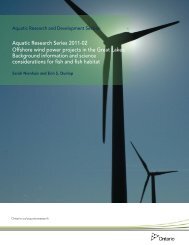Ontario's Natural Heritage Areas - Ministry of Natural Resources
Ontario's Natural Heritage Areas - Ministry of Natural Resources
Ontario's Natural Heritage Areas - Ministry of Natural Resources
Create successful ePaper yourself
Turn your PDF publications into a flip-book with our unique Google optimized e-Paper software.
Image by T.J. Beechey<br />
In selecting a potential National Marine Conservation<br />
Area, consideration is given to a range <strong>of</strong> factors,<br />
including:<br />
• Quality <strong>of</strong> regional representation.<br />
• Comparative importance for maintaining<br />
biodiversity.<br />
• Protection <strong>of</strong> endangered species critical habitat.<br />
• Outstanding natural or cultural features.<br />
• Current or anticipated marine protected areas.<br />
• Minimizing conflict with resource users.<br />
• Jeopardizing the sustainability <strong>of</strong> marine<br />
ecosystems.<br />
• Aboriginal claims and treaties implications.<br />
• Education and enjoyment potential.<br />
• Ecological research and monitoring value (Parks<br />
Canada, 2006a).<br />
The feasibility <strong>of</strong> establishing a National Marine<br />
Conservation Area is assessed during a collaborative<br />
process that can involve many participants, including<br />
federal, provincial, and territorial governments,<br />
communities, stakeholders, and Aboriginal peoples<br />
(Parks Canada, 2006a). In proposing the boundaries <strong>of</strong><br />
a potential National Marine Conservation Area, every<br />
effort is made to establish an area with a size and<br />
configuration that:<br />
• Protects a wide diversity <strong>of</strong> marine ecosystems<br />
representative <strong>of</strong> the marine region.<br />
• Accommodates the habitat requirements <strong>of</strong><br />
viable populations <strong>of</strong> marine species that are<br />
native to the marine region.<br />
• Does not fragment sensitive, highly diverse, or<br />
productive marine communities.<br />
• Protects exceptional marine phenomena, and<br />
rare, threatened, or endangered marine flora and<br />
fauna.<br />
• Includes important sites for ecological research<br />
and monitoring.<br />
• Offers opportunities for public understanding<br />
and enjoyment.<br />
• Results in minimum long-term disruption <strong>of</strong><br />
the social and economic life in the surrounding<br />
region.<br />
• Does not encompass permanent communities<br />
(Parks Canada, 1994:51).<br />
Management Objectives and/or Guidelines<br />
National Marine Conservation <strong>Areas</strong> are almost always<br />
associated with large and dynamic open ecosystems<br />
where the rates <strong>of</strong> change associated with many<br />
important ecological processes are rapid. Given the<br />
open, dynamic nature <strong>of</strong> aquatic ecosystems and their<br />
links to terrestrial ecosystems, management usually<br />
involves close collaboration and cooperation between<br />
many agencies and organizations (Parks Canada,<br />
1994:51). Instead <strong>of</strong> attempting to protect marine<br />
ecosystems in an unaltered state free <strong>of</strong> human<br />
activity (the primary goal in terrestrial National Parks),<br />
management effort in National Marine Conservation<br />
<strong>Areas</strong> is directed towards the conservation <strong>of</strong><br />
these areas in a manner comparable to the World<br />
Conservation Strategy prepared by the IUCN/UNEP/<br />
WWF in 1980 (Parks Canada, 1994:48). In this context,<br />
conservation embraces a number <strong>of</strong> management<br />
techniques, including preservation, maintenance,<br />
sustainable use, and restoration. Therefore, protection<br />
is attained through management <strong>of</strong> a range <strong>of</strong> human<br />
activities to ensure the greatest sustainable benefit to<br />
present generations while maintaining the potential<br />
<strong>of</strong> the area to meet the needs and aspirations <strong>of</strong><br />
future generations (Parks Canada, 1994:48).<br />
123 Ontario’s <strong>Natural</strong> <strong>Heritage</strong> <strong>Areas</strong>

















